Do not trust the "System Administrator Quota Update" scam emails
Phishing/ScamAlso Known As: System Administrator Quota Update spam
Get free scan and check if your device is infected.
Remove it nowTo use full-featured product, you have to purchase a license for Combo Cleaner. Seven days free trial available. Combo Cleaner is owned and operated by RCS LT, the parent company of PCRisk.com.
What is the "System Administrator Quota Update" scam email?
"System Administrator Quota Update" is the name of yet another phishing spam campaign. This term defines a mass-scale operation during which thousands of deceptive emails are sent.
The letters distributed through this campaign - claim that recipients' email inboxes have reached their storage limit and will not be able to receive/send messages. The goal of this spam mail is to promote a phishing website that is disguised as an email account sign-in page.
Sites of this type are designed to record information entered into them; in this case - account log-in credentials (i.e., email addresses and passwords). Hence, by trusting these scam emails, users can have their mail accounts stolen by scammers.
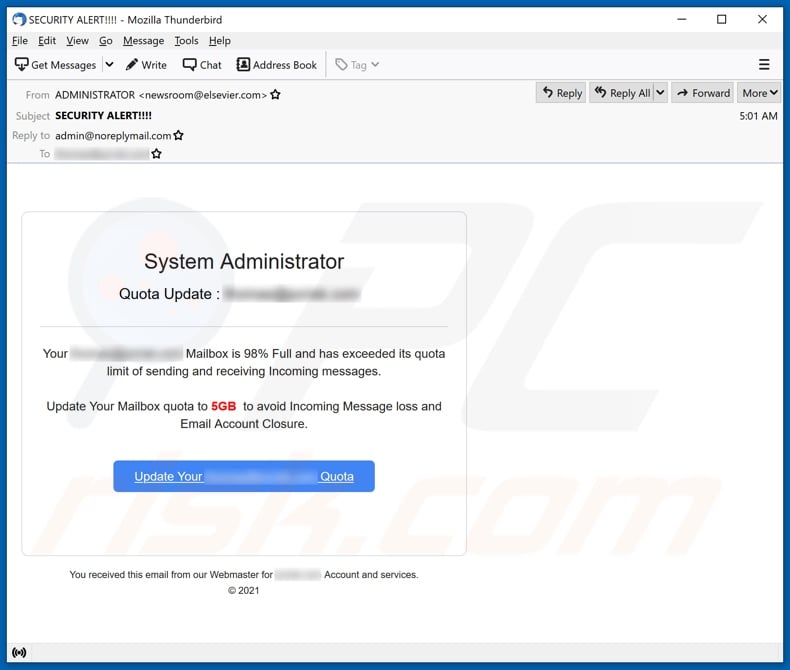
"System Administrator Quota Update" email scam overview
The "System Administrator Quota Update" scam emails (subject/title "SECURITY ALERT!!!!"; may vary) falsely state that recipients' mailboxes have reached 98% of their quota limit. This will supposedly prevent letters from being sent and received.
These deceptive emails instruct recipients to update their accounts to 5 GB storage - to avoid losing letters and prevent the mail account from being deactivated. Once the button presented in the emails is clicked - it leads to the promoted phishing website.
Trying to sign in through this page will expose the log-in credentials to the scammers, thereby allowing them to gain access and control over the corresponding email account. Emails are of particular interest to scammers and cyber criminals because they are commonly connected to other platforms and services (e.g., they can be registered through the emails).
Therefore, by obtaining emails - access/control may be gained over the accounts associated with them. To elaborate on how the hijacked accounts can be used, then communication platforms (e.g., emails, social networking/media, messengers, etc.) can be employed to proliferate malware by sharing malicious files or links.
Alternatively, scammers can pretend to be the accounts' genuine owners and ask the contacts/friends/followers for loans. Finance-related accounts (e.g., banking, e-commerce, online money transferring, digital wallet, etc.) can be used to make fraudulent transactions and/or online purchases.
To summarize, by trusting the "System Administrator Quota Update" scam letters - users can experience severe privacy issues, significant financial losses, identity theft, and other serious problems.
If attempts to sign in through the phishing website have already been made - it is advised to immediately change the log-in credentials of potentially compromised accounts. Furthermore, it is recommended to contact the official support of the endangered platforms and services.
| Name | System Administrator Quota Update Email Scam |
| Threat Type | Phishing, Scam, Social Engineering, Fraud |
| Fake Claim | Scam letters claim that recipients' email inboxes have reached their storage limit. |
| Symptoms | Unauthorized online purchases, changed online account passwords, identity theft, illegal access of the computer. |
| Distribution methods | Deceptive emails, rogue online pop-up ads, search engine poisoning techniques, misspelled domains. |
| Damage | Loss of sensitive private information, monetary loss, identity theft. |
| Malware Removal (Windows) |
To eliminate possible malware infections, scan your computer with legitimate antivirus software. Our security researchers recommend using Combo Cleaner. Download Combo CleanerTo use full-featured product, you have to purchase a license for Combo Cleaner. 7 days free trial available. Combo Cleaner is owned and operated by RCS LT, the parent company of PCRisk.com. |
Phishing spam campaign examples
"Outgoing Mail Error", "Verify Your Email Account", "Secure your email", "Monthly Email Validation" are a couple examples of phishing spam campaigns targeting email accounts. Scam letters are typically disguised as "official", "urgent", "priority", "important", and similar. Aside from phishing and other scams, deceptive emails are also used to distribute malware (e.g., trojans, ransomware, cryptocurrency miners, etc.).
Regardless of what scam emails promise, claim, request, or demand, their sole aim is to generate profit at user expense. Scammers and cyber criminals frequently use spam mail; therefore, it is strongly recommended to exercise caution with incoming emails.
How do spam campaigns infect computers?
Spam campaigns proliferate malware via infectious files sent through them. These files can be attached to the emails, and/or the letters can contain download links of such content.
Virulent files can be in various formats, e.g., archives (ZIP, RAR, etc.), executables (.exe, .run, etc.), PDF and Microsoft Office documents, JavaScript, and so forth. When the files are executed, run, or otherwise opened - the infection process (i.e., malware download/installation) is initiated.
For example, Microsoft Office documents infect systems by executing malicious macro commands. This process begins the moment a document is opened in Microsoft Office versions released before 2010.
Later versions have "Protected View" mode that prevents automatic execution of macros. Instead, users are asked to enable editing/content (i.e., macro commands) and warned of the risks.
How to avoid installation of malware?
To avoid infecting the system via spam mail, it is advised against opening suspicious and irrelevant emails - especially any attachments or links found in them. It is recommended to use Microsoft Office versions released after 2010.
Malware is also spread through untrustworthy download channels (e.g., unofficial and free file-hosting websites, Peer-to-Peer sharing networks, etc.), illegal activation ("cracking") tools, and fake updates. Therefore, it is important to only use official and verified sources.
Additionally, all programs must be activated and updated with tools/functions provided by legitimate developers. To protect device and user safety, it is crucial to have a dependable anti-virus/anti-spyware suite installed and kept up-to-date.
This software has to be used to run regular system scans and remove detected/potential threats. If you've already opened malicious attachments, we recommend running a scan with Combo Cleaner Antivirus for Windows to automatically eliminate infiltrated malware.
Text presented in the "System Administrator Quota Update" scam email letter:
Subject: SECURITY ALERT!!!!
System Administrator
Quota Update : ********
Your ******** Mailbox is 98% Full and has exceeded its quota limit of sending and receiving Incoming messages.
Update Your Mailbox quota to 5GB to avoid Incoming Message loss and Email Account Closure.
Update Your ******** Quota
You received this email from our Webmaster for ******** Account and services. © 2021
Screenshot of the phishing site promoted through the "System Administrator Quota Update" spam campaign:
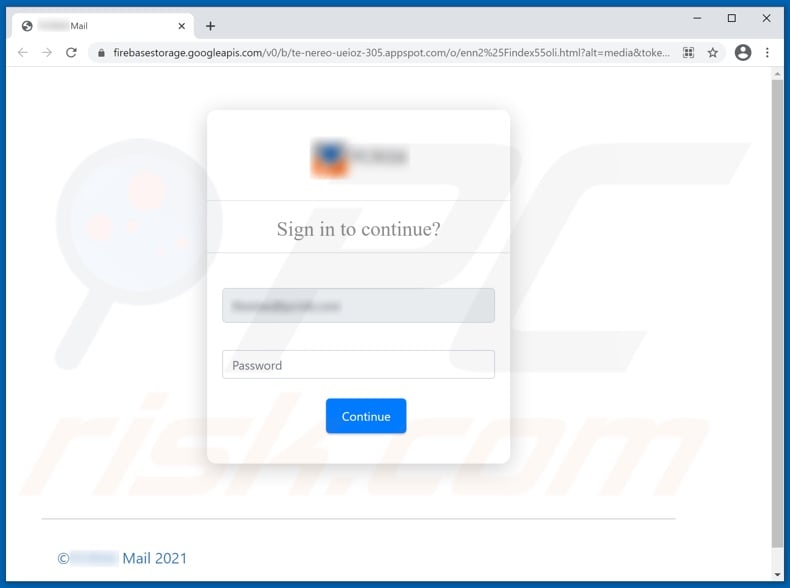
Another example of System Administrator Quota-themed spam email:
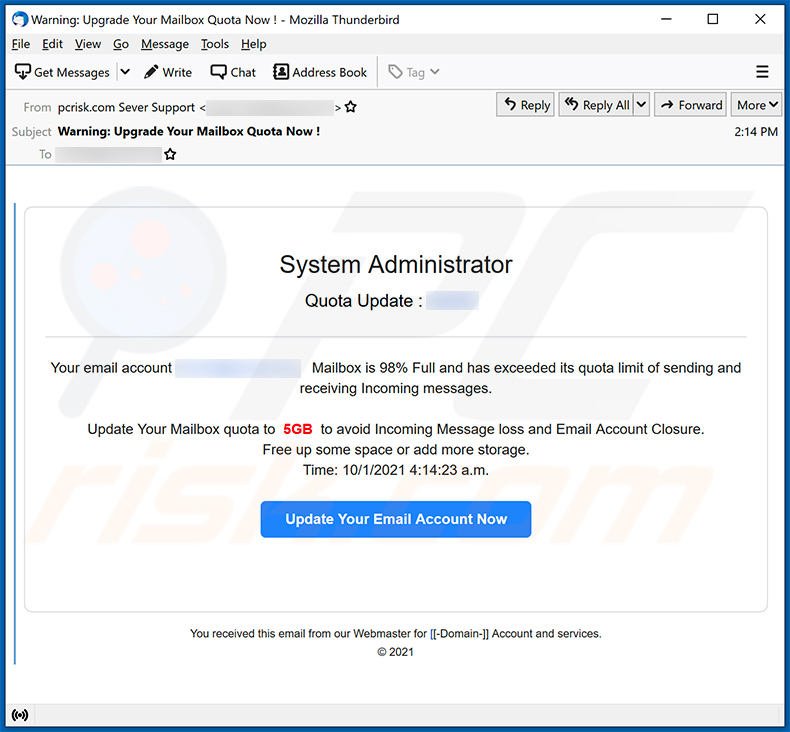
Text presented within:
Subject: Warning: Upgrade Your Mailbox Quota Now !
System Administrator
Quota Update : -
Your email account - Mailbox is 98% Full and has exceeded its quota limit of sending and receiving Incoming messages.
Update Your Mailbox quota to 5GB to avoid Incoming Message loss and Email Account Closure.
Free up some space or add more storage.
Time: 10/1/2021 4:14:23 a.m.Update Your Email Account Now
You received this email from our Webmaster for [[-Domain-]] Account and services.
© 2021
Screenshot of the promoted phishing site:
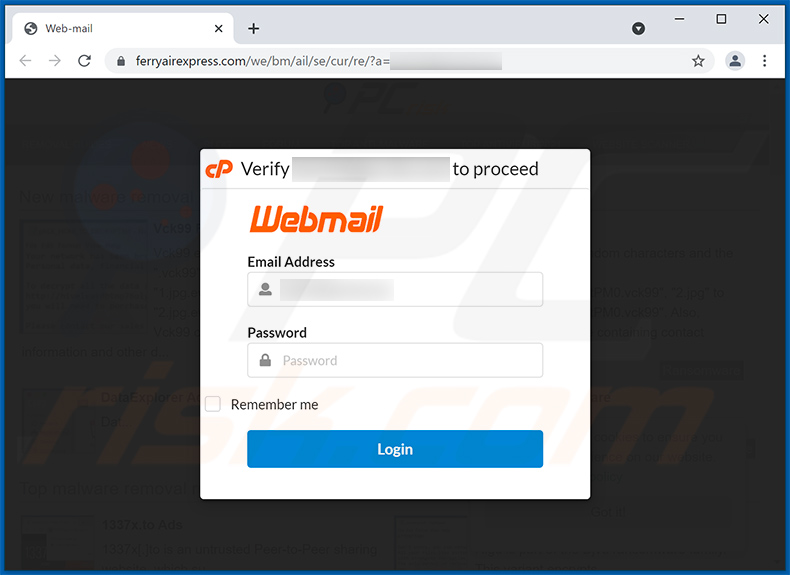
Yet another example of an email from "System Administrator Quota Update" spam campaign:
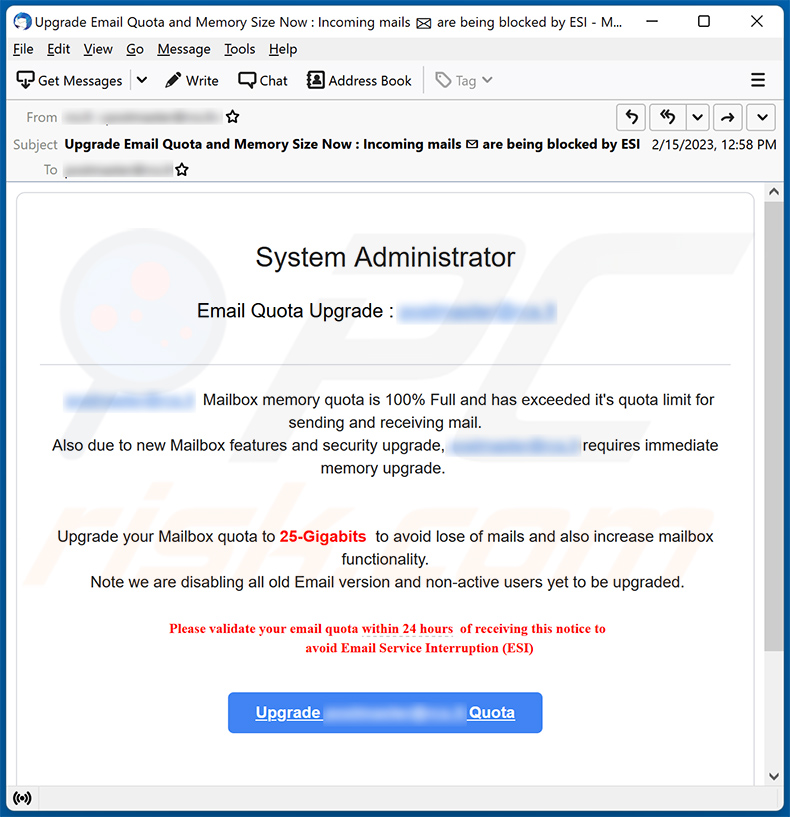
Text presented within:
Subject: Upgrade Email Quota and Memory Size Now : Incoming mails are being blocked by ESI
System Administrator
Email Quota Upgrade : ********
******** Mailbox memory quota is 100% Full and has exceeded it's quota limit for sending and receiving mail.
Also due to new Mailbox features and security upgrade, ******** requires immediate memory upgrade.
Upgrade your Mailbox quota to 25-Gigabits to avoid lose of mails and also increase mailbox functionality.
Note we are disabling all old Email version and non-active users yet to be upgraded.Please validate your email quota within 24 hours of receiving this notice to
avoid Email Service Interruption (ESI)
Upgrade ******** Quota
Yet another example of an email from "System Administrator Quota Update" spam campaign:
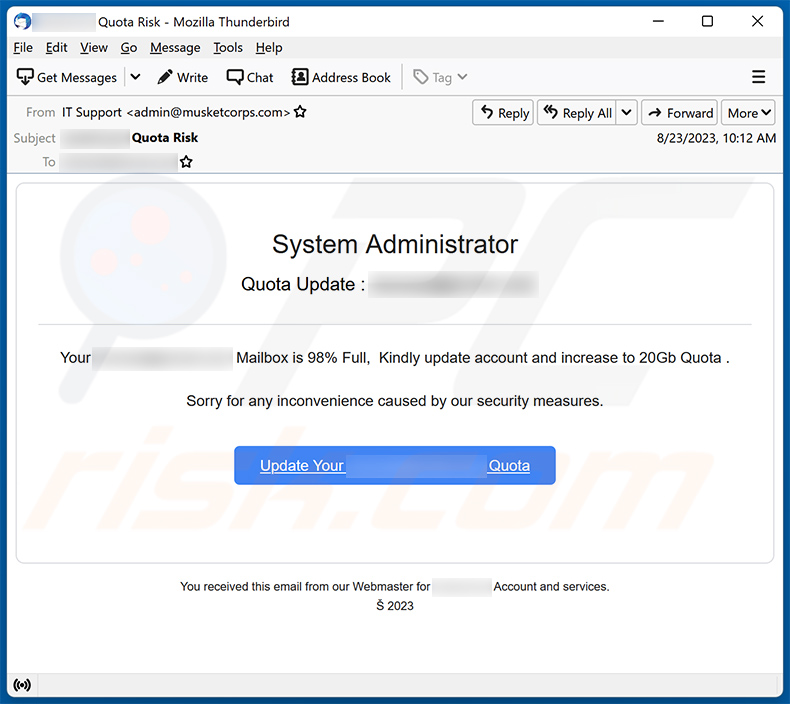
Text presented within:
Subject: ******** Quota Risk
System Administrator
Quota Update : ********
Your ******** Mailbox is 98% Full, Kindly update account and increase to 20Gb Quota .
Sorry for any inconvenience caused by our security measures.
Update Your ******** Quota
Screenshot of the promoted phishing site:
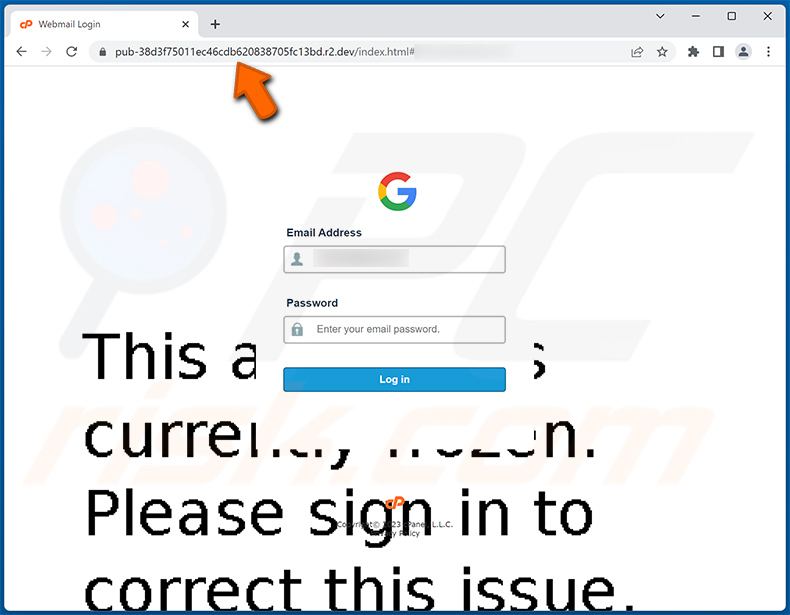
Instant automatic malware removal:
Manual threat removal might be a lengthy and complicated process that requires advanced IT skills. Combo Cleaner is a professional automatic malware removal tool that is recommended to get rid of malware. Download it by clicking the button below:
DOWNLOAD Combo CleanerBy downloading any software listed on this website you agree to our Privacy Policy and Terms of Use. To use full-featured product, you have to purchase a license for Combo Cleaner. 7 days free trial available. Combo Cleaner is owned and operated by RCS LT, the parent company of PCRisk.com.
Quick menu:
- What is System Administrator Quota Update spam?
- Types of malicious emails.
- How to spot a malicious email?
- What to do if you fell for an email scam?
Types of malicious emails:
![]() Phishing Emails
Phishing Emails
Most commonly, cybercriminals use deceptive emails to trick Internet users into giving away their sensitive private information, for example, login information for various online services, email accounts, or online banking information.
Such attacks are called phishing. In a phishing attack, cybercriminals usually send an email message with some popular service logo (for example, Microsoft, DHL, Amazon, Netflix), create urgency (wrong shipping address, expired password, etc.), and place a link which they hope their potential victims will click on.
After clicking the link presented in such email message, victims are redirected to a fake website that looks identical or extremely similar to the original one. Victims are then asked to enter their password, credit card details, or some other information that gets stolen by cybercriminals.
![]() Emails with Malicious Attachments
Emails with Malicious Attachments
Another popular attack vector is email spam with malicious attachments that infect users' computers with malware. Malicious attachments usually carry trojans that are capable of stealing passwords, banking information, and other sensitive information.
In such attacks, cybercriminals' main goal is to trick their potential victims into opening an infected email attachment. To achieve this goal, email messages usually talk about recently received invoices, faxes, or voice messages.
If a potential victim falls for the lure and opens the attachment, their computers get infected, and cybercriminals can collect a lot of sensitive information.
While it's a more complicated method to steal personal information (spam filters and antivirus programs usually detect such attempts), if successful, cybercriminals can get a much wider array of data and can collect information for a long period of time.
![]() Sextortion Emails
Sextortion Emails
This is a type of phishing. In this case, users receive an email claiming that a cybercriminal could access the webcam of the potential victim and has a video recording of one's masturbation.
To get rid of the video, victims are asked to pay a ransom (usually using Bitcoin or another cryptocurrency). Nevertheless, all of these claims are false - users who receive such emails should ignore and delete them.
How to spot a malicious email?
While cyber criminals try to make their lure emails look trustworthy, here are some things that you should look for when trying to spot a phishing email:
- Check the sender's ("from") email address: Hover your mouse over the "from" address and check if it's legitimate. For example, if you received an email from Microsoft, be sure to check if the email address is @microsoft.com and not something suspicious like @m1crosoft.com, @microsfot.com, @account-security-noreply.com, etc.
- Check for generic greetings: If the greeting in the email is "Dear user", "Dear @youremail.com", "Dear valued customer", this should raise suspiciousness. Most commonly, companies call you by your name. Lack of this information could signal a phishing attempt.
- Check the links in the email: Hover your mouse over the link presented in the email, if the link that appears seems suspicious, don't click it. For example, if you received an email from Microsoft and the link in the email shows that it will go to firebasestorage.googleapis.com/v0... you shouldn't trust it. It's best not to click any links in the emails but to visit the company website that sent you the email in the first place.
- Don't blindly trust email attachments: Most commonly, legitimate companies will ask you to log in to their website and to view any documents there; if you received an email with an attachment, it's a good idea to scan it with an antivirus application. Infected email attachments are a common attack vector used by cybercriminals.
To minimise the risk of opening phishing and malicious emails we recommend using Combo Cleaner Antivirus for Windows.
Example of a spam email:

What to do if you fell for an email scam?
- If you clicked on a link in a phishing email and entered your password - be sure to change your password as soon as possible. Usually, cybercriminals collect stolen credentials and then sell them to other groups that use them for malicious purposes. If you change your password in a timely manner, there's a chance that criminals won't have enough time to do any damage.
- If you entered your credit card information - contact your bank as soon as possible and explain the situation. There's a good chance that you will need to cancel your compromised credit card and get a new one.
- If you see any signs of identity theft - you should immediately contact the Federal Trade Commission. This institution will collect information about your situation and create a personal recovery plan.
- If you opened a malicious attachment - your computer is probably infected, you should scan it with a reputable antivirus application. For this purpose, we recommend using Combo Cleaner Antivirus for Windows.
- Help other Internet users - report phishing emails to Anti-Phishing Working Group, FBI’s Internet Crime Complaint Center, National Fraud Information Center and U.S. Department of Justice.
Frequently Asked Questions (FAQ)
Why did I receive this email?
Spam emails are not personal. This mail is spread in large-scale operations – hence, thousands of users receive identical emails.
I have provided my personal information when tricked by this spam email, what should I do?
If you have disclosed your log-in credentials – change the passwords of all possibly exposed accounts and contact their official support without delay. And if you've provided other private information (e.g., ID card details, passport photos/scans, credit card numbers, etc.) – immediately change the passwords of all possibly exposed accounts.
I have read a spam email but didn't open the attachment, is my computer infected?
Merely reading an email is harmless; devices are infected when malicious attachments or links are opened.
I have downloaded and opened a file attached to a spam email, is my computer infected?
If the opened file was an executable (.exe, .run, etc.) – most likely, yes – your system was infected. However, you might have avoided this if it was a document (.doc, .xls, .one, .pdf, etc.). These formats might need additional actions to jumpstart malware download/installation chains (e.g., enabling macro commands, clicking embedded files/links, etc.).
Will Combo Cleaner remove malware infections present in email attachments?
Yes, Combo Cleaner is capable of detecting and eliminating most of the known malware infections. It must be stressed that since sophisticated malicious programs usually hide deep within systems – running a full system scan is paramount.
Share:

Tomas Meskauskas
Expert security researcher, professional malware analyst
I am passionate about computer security and technology. I have an experience of over 10 years working in various companies related to computer technical issue solving and Internet security. I have been working as an author and editor for pcrisk.com since 2010. Follow me on Twitter and LinkedIn to stay informed about the latest online security threats.
PCrisk security portal is brought by a company RCS LT.
Joined forces of security researchers help educate computer users about the latest online security threats. More information about the company RCS LT.
Our malware removal guides are free. However, if you want to support us you can send us a donation.
DonatePCrisk security portal is brought by a company RCS LT.
Joined forces of security researchers help educate computer users about the latest online security threats. More information about the company RCS LT.
Our malware removal guides are free. However, if you want to support us you can send us a donation.
Donate
▼ Show Discussion